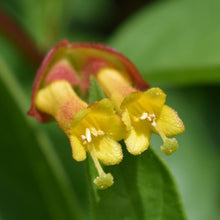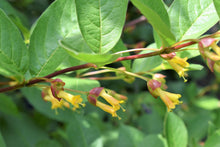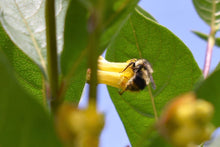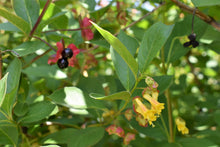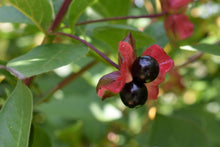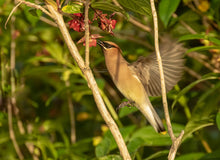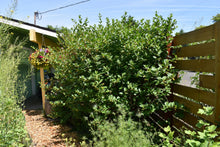
Lonicera involucrata
Black Twinberry is a member of the Honeysuckle family, forming a beautifully arching tall and wide upright shrub. Seemingly thousands of pairs of yellow, tubular flowers emerge in April and continue blooming all summer long, providing nectar to countless species of insect pollinators and making it a magnet for hummingbirds. As the season progresses, the flowers become encased in showy red bracts that eventually hold its shiny black, “twin” berries, the namesake of this lovely garden shrub.
- Plant type/canopy layer: deciduous, perennial, large shrub
- Size at maturity: 5-8' tall, 2-8' wide
- Light requirements: full sun to part shade
- Moisture requirements: moist to wet soil
- Bloom time: March - August (April - Aug in the Portland Metro area)
- Growth rate/ease: fast growing, easy to grow
- Wildlife support: flowers are a favored nectar source for hummingbirds, adult butterflies, bees, and other insect pollinators; berries are eaten by many species of resident and migratory birds; overall plant attracts and supports beneficial and other pest eating insects and is a caterpillar host plant and larval food source for native moths and butterflies
- Native habitat/range: locally common in meadows, forest edges, bogs, fens and wetlands across much of south western Canada and all of Washington, Oregon south into California. Portland Plant List - yes.
- Special features & uses: hummingbird magnet; landscape uses include pollinator gardens, raingardens, erosion control and habitat hedgerows
Gardening with Black Twinberry: This fast growing shrub is carefree when planted in the right place. Be sure to give it a part to full sun location with moist soil, such as a sunny raingarden. It can even tolerate seasonal flooding and will help stabilize soils in these areas. Since it is adored by hummingbirds, place it in an area where it can be viewed from a window to enjoy entertainment all summer long.
Photo Credits 1-5 & 7: Nikkie West
Photo Credit 6: Photo Credit 2: "Kayaking, looking for the beaver found cedar waxwings feeding on the lonicera involucrata... black twinberry." by island deborah- New Book 'Song of the Sparrow' vig is licensed under CC BY-SA 2.0







